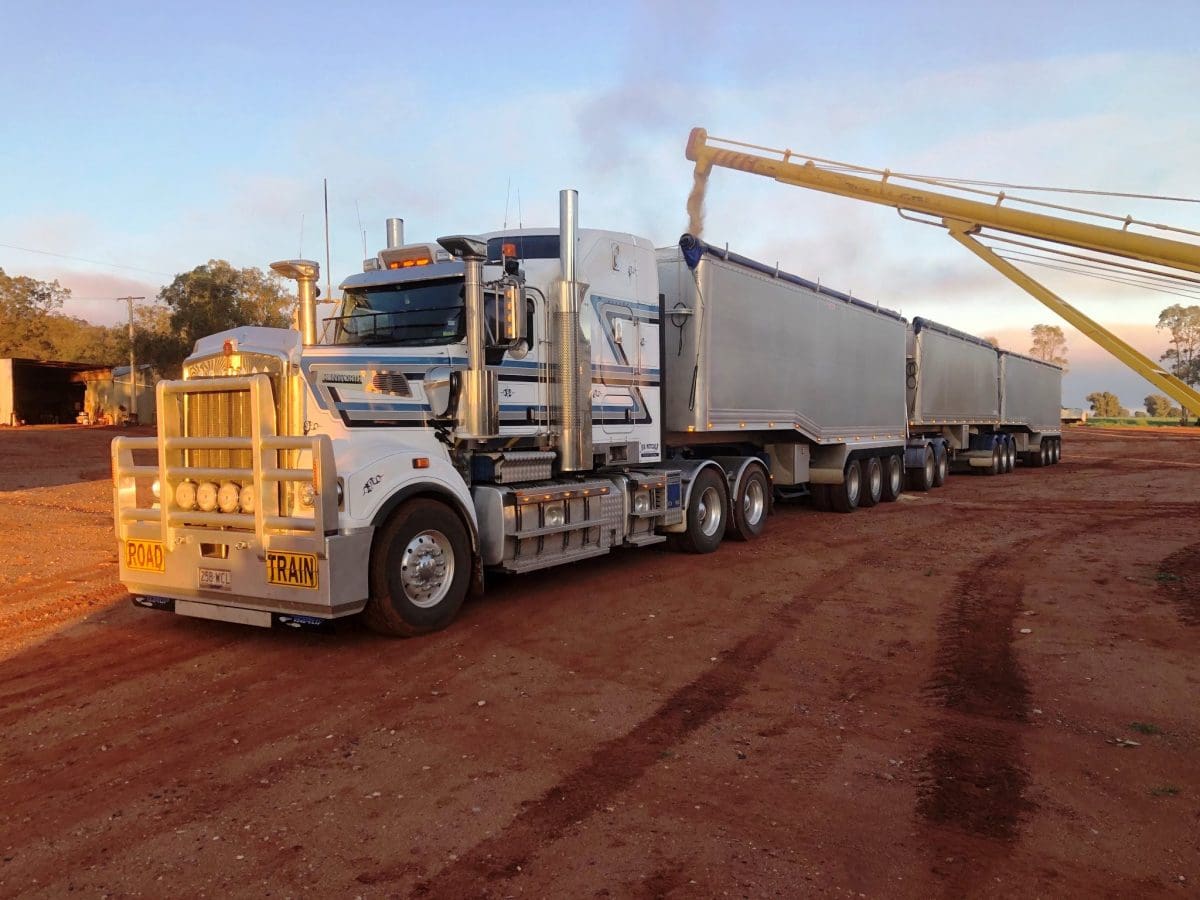
Barley coming by road from NSW and Victoria continues to be a major supplier to Queensland feedlots. Photo: Anthony Morris, Naradhan
ALL EYES are turning to Victoria as the last place for domestic consumers to pull grain in volume, lifting southern markets for barley and wheat by $5-$10 per tonne this week.
Further support has come from the jump in United States wheat futures overnight, and trade sources have said new nearby export business is helping to run down the carryout ahead of new crop.
Normal seasonal conditions prevailing, this will be available in limited volume in September to Queensland consumers before harvest gets going in New South Wales in October and Victoria in November.
“Victoria has got the carry-over,” one trade source said.
“If you’re trying to get it from anywhere other than Victoria, you’ve got an executional nightmare on your hands.”
Firming values have attracted some grower selling, but any increase in supply-side pressure is expected to push downs bids to the point where growers lose interest in meeting the market.
| This week | Last week | Change | |
| Barley Downs July-August | $345 | $345 | Steady |
| Barley Downs Jan | $265 | $265 | Steady |
| Barley Melbourne July | $270 | $265 | Up |
| Barley Melbourne Jan | $243 | $245 | Down |
| Wheat Downs July | $400-$405 | $395-$397 | Up |
| Wheat Downs Jan | $295-$300 | $302 | Down |
| Wheat Melbourne August | $343 | $330-$335 | Up |
| Wheat Melbourne Jan | $292 | $290 | Up |
| Sorghum Downs July | $325 | $323 | Up |
| Sorghum Downs Mar-Apr | $282 | $275-$280 | Up |
Table 1: Indicative delivered grain prices in AUD per tonne.
Tight in South Australia
In its monthly receivals report issued this week, SA bulk-handling major Viterra said receivals of 5405t between 1 June and 5 July had lifted total grain intake since 8 October 2019 to 4 million tonnes.
“The amount of wheat and barley remaining in our network has dipped to 700,000t, following over 400,000t of outturns in June as we continued to meet strong demand for grain within the Viterra network,” Viterra said.
“We moved tonnes quickly with the buyers in our system sending grain to multiple domestic and international end-use destinations.”
While the position of Cargill’s Grainflow as eastern SA’s second-biggest bulk handler is not known, trade sources have said it has also been running down stocks by booking exports and railing grain into northern NSW.
“If SA keeps going like it has, they’ll be out by September,” one market commentator said.
Sources report Victorian grain is now going into SA as well as NSW and Queensland.
“It’s been a hit and miss market in the past three weeks,” Australian Grain Export director Tim Martin said.
“A month ago, a lot of people had long positions of 2000-3000t, and they quit them because the market had gotten down to limited domestic buyers.
“We’ve seen that turn around now, and new crop and old crop are firming.
“SA stocks were always going to dwindle.”
“It feels tight on the wheat, and SA is at parity with Victoria when normally it trends more towards WA on being export based because SA has such a small domestic demand,” a further source said.
Traders report old-crop values as being choppy, and say consumers are comfortable to buy small amounts on dips in the market prompted by fluctuations in the Australian dollar.
Limited new-crop selling
Agracom export manager Brett Donoghue said growers on the Liverpool Plains of northern NSW were not seeing bids on new-crop as attractive.
“Values growers are seeing have dropped to a point where if the price is lower at harvest, they feel what they gain in yield will make up for that.”
Wheat and barley crops on the Liverpool Plains have above-average yield potential and, quality permitting, a big chunk of the NSW crop looks destined for export.
“If the potential is realised on the east coast, there’s no way around that.
“We’re certainly competitive into Asia in new-crop on milling wheat.
“We’ve already connected on new-crop into bulk and container markets.”
Mr Donoghue said the lights appeared to have gone out on the domestic wheat transshipment market.
“Prices haven’t encouraged more wheat to come around on vessels.
“No trader is going to take that risk on 30,000t.”
The exception may be GrainCorp, which owns two terminals in Victoria, and the big receiving sites in Brisbane and Newcastle.
“They might do it because they can clip the ticket at both ends,” one trader said.
Feedlots are generally seen as covered until the end of August, and most have some or all of their September requirements booked, which should see them through to new crop.
Waiting for rain
The eight-day Bureau of Meteorology forecast is predicting falls of 10-25 millimetres for the eastern third of Australia’s grainbelt.
If realised, the rain would soften new-crop prices by consolidating yield prospects for early sown wheat and barley crops.
Sorghum has firmed a few dollars, possibly on the back of an expected pick-up in demand when Dalby Bio-Refinery resumes operations next month.
ASX
ASX barley January 21 futures since mid-June have traded in a range a few dollars either side of $230/t. Settlement last Thursday was $233.50/t and it traded to a low on Tuesday at $225/t, settling yesterday at $229.50.
ASX east-coast wheat futures January 2021 traded 1176 lots this week. The contract settled yesterday at $290/t, having marked small changes each day this week except last Friday, when it lost the $6/t it gained the previous day.
Grain Central: Get our free daily cropping news straight to your inbox – Click here

HAVE YOUR SAY